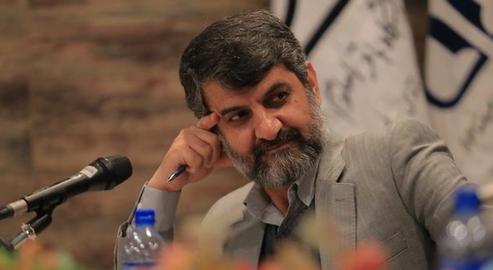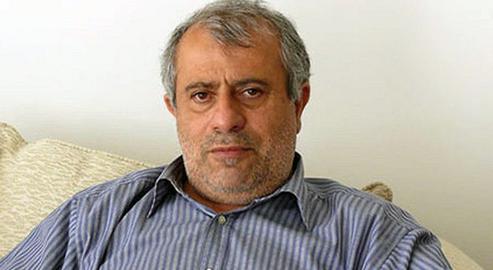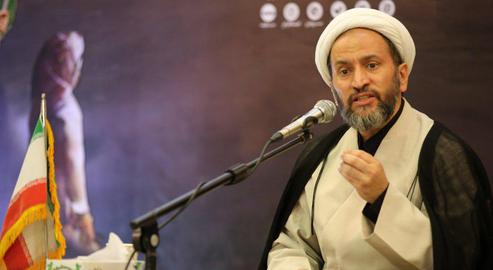This week a televised debate on Iranian television sparked astonishment among social media users. The discussion between Mehdi Nasiri, the former editor-in-chief of Kayhan newspaper, and Hossein Suzanchi, an associate professor at Bagher al-Olum Islamic University, centred around compulsory veiling in Iran and was aired on the state-owned Channel 4 on Wednesday. Many startled viewers wondered: is this the first time someone within the government has criticized the hijab in Iran?
***
This week the remarks of Mehdi Nasiri, an Iranian cleric and former editor of Kayhan newspaper, on compulsory veiling in Iran caused a stir on social media.
In a televised debate with seminary student Hossein Suzanchi, Nasiri claimed that although hijab was a "religious necessity", it should not be enforced as compulsory in Iran, because doing so was actively discouraging women from veiling.
“Non-observance of the hijab is not our red line,” he said, “and we made a mistake to count it as a red line. Over the years we have backtracked on issues such as satellite, video tapes and the presence of women in stadiums, and I think this time, too, we will end up paying a delayed, high cost.
“The way we handled and confronted non-observance of hijab from the beginning of the [Islamic] Revolution was not effective. Sometimes it has led to the opposite result.”
Nasiri went on to cite “different surveys and polls” that, he said, showed a two percent annual decline in use of the hijab by Iranian women. Meanwhile, he said, the rate of non-observance of “the proper religious hijab” was 70 percent. “Many of our women who wear chador are against our method of handling hijab in society,” he concluded.
His opponent in the debate, Hossein Suzanchi, was an associate professor at Baqer al-Olum University and the author of a book entitled Hijab in Qur’anic Verses and Hadith: a rebuttal to the theologian Amirhossein Tarkashvand, who has written about the relative absence of hijab during the time of the Prophet Muhammad.
Suzanchi insisted the issue of hijab in Iran was one of "moral health", and claimed that just as the government had a duty to protect Iranians’ physical health by fighting coronavirus, it had a duty toward moral health by enforcing the hijab. He also said that most of those opposed to compulsory veiling were Iran’s educated, metropolitan elite.
Should we be Surprised?
Nasiri’s remarks were surprising to some because of his track record as former editor-in-chief of the ultra-conservative Kayhan newspaper from the late 1980s. In 1991 he also became the paper’s managing director by decree of Ayatollah Khamenei. Then in 1995 he left Kayhan to publish Sobh magazine, which also published articles criticizing women’s cycling in the strongest possible terms.
But in 1999, Sobh magazine was closed and Nasiri returned to the seminary. What has received less attention in the 20 years since then has been his frustration and isolation, as a cleric with links to the government whose views have matured over time. In the past he has held forth on issues from corruption to economic stagnation in Iran, as well as a lack of pragmatism in religious edicts, arguing: “We should approach the issue of a religious civilization in a measured and calculated way, not regardless of the current realities in society... Our seminaries do not know at all what has happened in the world during the last hundred years.”
Perhaps for this reason, despite the controversy Mehdi Nasiri's remarks stirred up in cyberspace, they caused barely a stir in the political arena. He is also not the first cleric in the government to have made such remarks on the issue of compulsory veiling.
In 2015 the conservative cleric Hojatoleslam Mohammad Reza Zaeri called Iranian state policy on the hijab “wrong-headed”, and argued it was having the opposite of the intended effect.
"It’s as if I closed the door of this room and told you that you had to stay here for three hours and watch a movie,” he said on state television that March, “and then I repeatedly explained to you that this movie had won an Oscar for its artistic value. When you're forced into [something], the praise is meaningless.”
Zaeri was later notified by the office of the Supreme Leader about the “social and legal obligation of hijab”: a form of soft reprimand. In a comment piece subsequently published in Sharq newspaper, Zaeri reiterated his long-held view and said it “had not changed” with the words of the Supreme Leader – but at the same time, in accordance with the Islamic Republic’s founding principle of Velayat-e faqih or guardianship of the Islamic jurist, he had to consider the leader’s opinion to be the final verdict.
Years of Vacillating Public Debate
Compulsory veiling has been a politically-charged issue ever since it was introduced following the 1979 Islamic Revolution. The debate has always been a nuanced one: in addition to supporters of compulsory veiling, and those that outright object to the hijab in any situation, there has always existed a group that believe in the principle of veiling but believe it should not be enforced by the state.
The cleric Ayatollah Reza Sadr, who served in the cabinet of the Revolutionary Council, went so far as to write an article entitled In the Prison of Velayat-e Faqih, in which he said: "I have heard that women whose hair comes out of their headscarves are fined. During the reign of Prophet and Imam Ali, they did not do this to any woman.
“Why do they interfere with what people wear? Why don't they use their forces to enact reforms? Why do they make people hate Islam? There is no special dress code proscribed for any man or woman in Islam."
During the presidency of Akbar Hashemi Rafsanjani from 1989 to 1997, some of the restrictions on women’s freedoms were reduced. With this change in the cultural atmosphere came a renewal of the hijab debate, with the president’s own daughter Faezeh Hashemi advocating for a more relaxed dress code.
The debate grew all the more lively during the tenure of reformist president Mohammad Khatami. That was not to say, however, that all Iranian public figures had a free pass to criticize veiling during this period.
At the 2000 Berlin Conference on social and cultural reform in Iran, the then-cleric and researcher Hassan Yousefi Eshkevari stressed that the social rules of Islam – including veiling – were changeable, and hijab a cultural custom. On his return from Germany Eshkevari was arrested and tried by the Special Court of the Clergy, which initially issued him with a death sentence for his speeches in Berlin.
The philosopher and professor of Islamic Studies Mohsen Kadivar has written of the court’s decision: "None of the religious sources of emulation in Qom supported the execution of such a sentence. However, they were not happy with Eshkevari's modernist views."
Eshkevari was subsequently defrocked and his sentence commuted to seven years in prison, of which he served three. He later fled to Germany in 2009.
Other clerics, known as religious modernizers, have also refuted the obligation of hijab. Some do not even consider it necessary for a woman to cover her head and neck at all. In his book Rulings on Women in Mohammad's Religion, after examining Qur’anic verses, hadith, and opinions of jurists, the late Shia cleric Ahmad Ghabel came to the conclusion that it was only the body that should be covered.
In the run-up to the 2005 presidential election, all of the candidates were forced to implicitly or explicitly address the issue of compulsory veiling. Mahmoud Ahmadinejad famously went so far as to demand, "Is the hair of our youth really our problem?"
This process continued in the 2009 presidential elections, with supporters of reformist candidate Mehdi Karoubi chanting the slogan: "Optional hijab is the right of Iranian women." Mir Hossein Mousavi also announced in an interview with Etela'at newspaper that if elected, he would abolish the Guidance Patrols: vice squads established in 2005 to arrest women deemed to be improperly dressed in public.
With the words of Mehdi Nasiri, the issue of compulsory hijab has once again been brought to the fore. Opposition to the policy has, in fact, simmered both in the seminaries and the streets of Iran since the foundation of the Islamic Republic. But there remains a core group of clerics that consider the hijab a symbol of Iran itself. Unless this changes, it seems likely the law will remain in place.
visit the accountability section
In this section of Iran Wire, you can contact the officials and launch your campaign for various problems



























comments